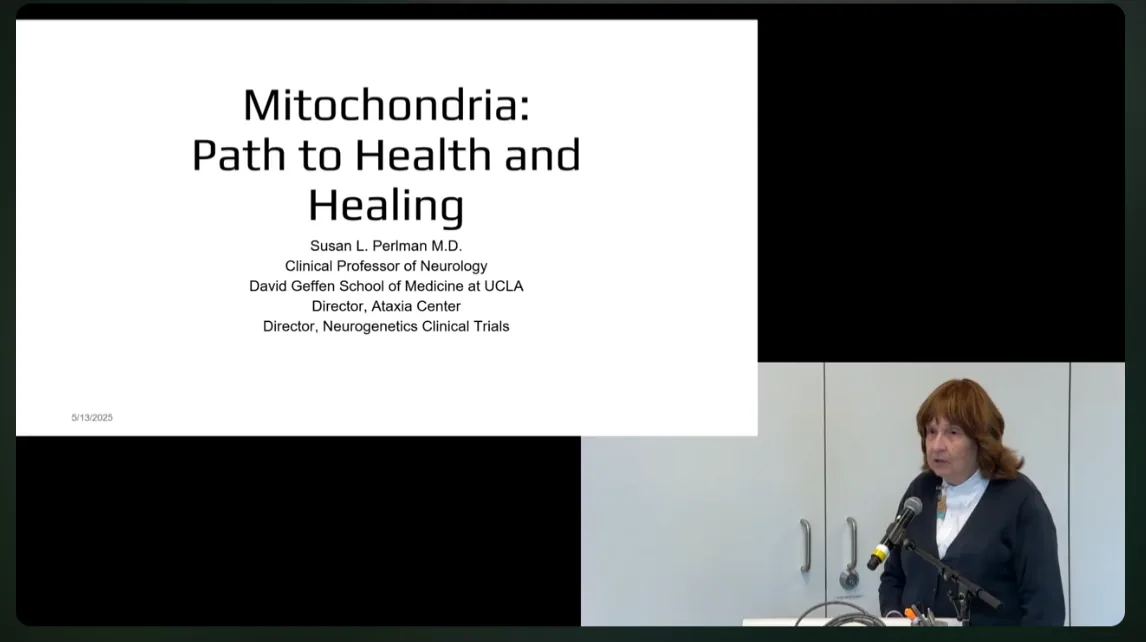Mitochondria: Path to Health and Healing by Dr. Susan Perlman
Published July 2025
Dr. Susan Perlman, one of the world’s leading neurologists and clinical researchers in Friedreich’s ataxia and runs a clinic for the FA community at UCLA, delivered a comprehensive overview of mitochondrial health. The event was held May 13, 2025 BlueOakNx event held at the UCLA Mathias Botanical Gardens in Los Angeles.
NOTE: This article is a synopsis of the key highlights of Dr. Pearlman’s talk.
Key Themes and Insights
Mitochondria as Cellular Powerhouses
Dr. Perlman emphasized that mitochondria are far more than simple energy producers. These organelles, believed to have originated from ancient bacterial cells through endosymbiosis, serve multiple critical functions including calcium balance, immune system support, programmed cell death regulation, and hormone signaling.
Each cell can contain thousands of mitochondria, with muscle and nerve cells requiring the highest concentrations due to their energy demands. A more detailed read on our blog: What are Mitochondria and Why are they Important.
The Multi-System Nature of Mitochondrial Disease
A hallmark insight from the presentation was how mitochondrial dysfunction creates multi-systemic problems.
Dr. Perlman illustrated how a patient might see multiple specialists—orthopedists for skeletal issues, cardiologists for heart problems, and neurologists for neurological symptoms—without anyone initially recognizing the underlying mitochondrial connection.
This tunnel vision approach can delay proper diagnosis and treatment.
Prevalence and Diagnostic Challenges
The speaker noted that mitochondrial diseases affect approximately 1 in 5,000 people, though this may be an underestimate due to frequent misdiagnosis.
With 270-400 identified mitochondrial diseases and over 350 now identifiable through genetic testing, the field has expanded significantly as diagnostic capabilities have improved.
Treatment Landscape
Dr. Perlman outlined current treatment approaches, noting that most focus on symptom management rather than addressing root causes.
She highlighted two US FDA-approved treatments:
- Skyclarys (omaveloxolone): The first FDA-approved drug specifically for mitochondrial disease, initially approved for Friedreich’s ataxia
- Idebenone: A modified form of CoQ10 that better penetrates the nervous system
Emerging Research Directions
The presentation covered several promising research avenues:
- Antioxidant therapies using vitamins C and E, polyphenols, and other compounds
- Nitric oxide restoration therapy
- MitoQ (modified CoQ10) showing promise in multiple active trials
- Gene therapy approaches, though still years away from practical application
Connection to Aging and Degenerative Diseases
Dr. Perlman drew important connections between mitochondrial dysfunction and common neurodegenerative diseases including Huntington’s, Alzheimer’s, Parkinson’s, and ALS, suggesting that mitochondrial health may be a key factor in aging and neurodegeneration.
Clinical Research Activity
The speaker noted robust research activity with 97 active clinical trials for mitochondrial diseases currently listed on ClinicalTrials.gov, with an additional 409 completed studies providing valuable data even when they didn’t reach statistical significance.
Notable Perspectives
Dr. Perlman’s presentation balanced scientific rigor with accessibility, acknowledging both the complexity of mitochondrial science and the practical challenges faced by patients and families. Her emphasis on international collaboration through initiatives like the Ataxia Global Initiative reflects the reality that rare disease research requires coordinated global efforts to achieve meaningful progress.
The talk effectively conveyed that while mitochondrial diseases remain challenging to treat, the field is advancing rapidly with new therapeutic approaches and a growing understanding of these fundamental cellular processes that affect health and aging.
Watch the video.



